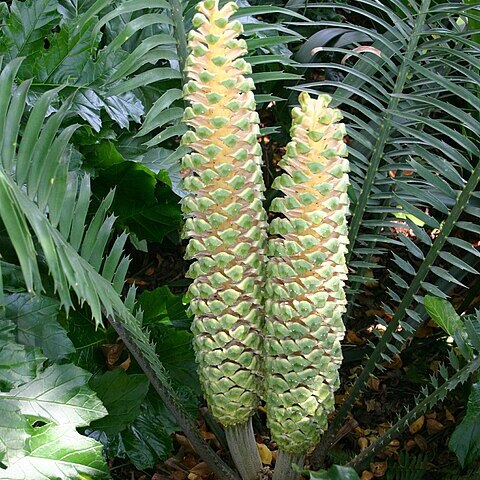Stemless, with about 9 leaves arising from the ground in a circle more or less 20 cm in diameter. Leaves rather dark green (new leaves woolly becoming glabrous) up to 2 m long, suberect with the upper half gradually curving outwards; leaflets in many pairs, Varley's Green (R.C.S.) above and Forest Green (R.C.S.) beneath (veins slightly raised beneath), opposite or alternate, mostly somewhat ovate-lanceolate (in typical form broadly linear), up to about 20 cm long and 2-4 cm broad in upper two-thirds of the leaf, gradually smaller in size towards the apex; with the apical ones about 9 cm long and 1-4 cm broad, also gradually smaller towards the base until about 35 cm from the ground, when they reduce abruptly into spines; apex pungent pointed; margins sparsely dentate with sharp ascending teeth, usually with a tooth on either side and just below the apex; petiole (i.e. portion below basal spines) about 9 cm long, below ground level, with base yellowish brown, white woolly on the inner face and surrounded by ovate scales; scales about 10 cm long and 5 cm broad, densely matted with off-white wool on the back. Female cone with peduncle dark spinach green, 13 cm long, 4 cm diameter; seeding portion 40 cm long, 11 cm diameter; scales cadmium yellow to orange yellow, the faces about 5 cm in horizontal width and 2-5 cm in perpendicular width, imbricating in about 16 spirals, each with the lower edge wedge like, obscurely and irregularly notched, and with an indication of a rhomboid surface just above this edge; seed scarlet to Brazil Red (R.C.S.) about 3.3 cm long, 1.8 cm diameter; area of attachment whitish, perforated, about 7 mm diameter.
Plant dioecious, palm-like. Stem subterranean, unbranched or branched from base, covered by alternating series of woody bracts and persistent, swollen, truncated leaf bases (pulvini). Leaves petiolate, pinnate with rachis recurved; median leaflets dentate or entire, pungent-pointed; reduced in size towards base of rachis. Cones Mar.-Oct., 1-5, appear sessile, yellowish green. Male cones oblanceoloid, 400-820 mm long. Female cones cylindric to ovoid, 300-760 mm long, broader than male, facets glabrous.
Leaves up to 2 m. long, recurved, densely woolly when young, glabrate; leaflets up to 20 x 1.8 cm., linear or narrowly oblong, ± straight, margin with usually 1–5 spines on either side more closely set apically, sometimes entire especially on the distal side; leaflets reducing in size and becoming oblong towards the base, ceasing abruptly or reducing ultimately to simple spines; petiole 20–50 cm. long.
Male cones up to 60 x 10 cm., cylindric, strongly smelling; peduncle up to 20 cm. long; median cone-scales ascending with the head deflexed so that the terminal facet is retained in a plane parallel to the axis of the cone; head rhombic with a rounded dentate adaxial margin, terminal facet rhombic and flat.
A small cycad. It forms clumps. The stems are 40 cm tall and 25 cm across. The young leaves have white hairs. The mature leaves are dark green and shiny. They are light green underneath. They are 3 m long. The female cones are deep yellow. There are many seeds.
Female cones up to 45 cm. long, oblong, ovoid, yellowing, pedunculate; median cone-scales straight with the head much inflated; head elliptic with somewhat blunted edges; adaxial margin rounded and medially dentate, terminal facet deflexed.
Trunk not developed, only the crown above ground.
Seeds 3 cm. long, ovoid, crimson.


